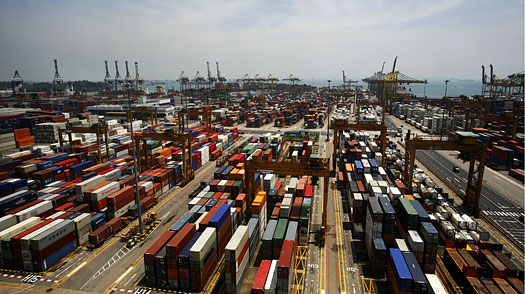
The great recession hasn’t been great for free trade. As unemployment has risen throughout the world, governments have become more focused on protecting their own industries than on promoting international commerce. The U.S., typically an enthusiastic supporter of open markets, included “buy American” clauses in its stimulus package and propped up its flailing auto industry with handouts. Although a meeting of ministers in New Delhi in early September promised to restart long-stalled World Trade Organization negotiations aimed at reaching a global consensus on freer trade, wide differences remain between developed and developing nations that make a final deal difficult.
Yet against this dim backdrop, the part of the world that was hit hardest by the trade crash — Asia — has been actively opening up its regional markets. According to the Asian Development Bank , the number of free-trade agreements signed by Asian countries has grown from just three in 2000 to 56 by the end of August. Nineteen of those FTAs are among 16 Asian economies, a trend that could help the region become a powerful trading bloc. “Asian integration is sort of a dream, but it is much more realistic than it was before,” says Ganeshan Wignaraja, an ADB economist. “There is a move toward making a better business environment in Asia. The momentum is quite strong.”
That can be seen clearly in the continuing stream of agreements tying together regional powers. In August, India inked two FTAs in a week, with South Korea and the 10-member Association of Southeast Asian Nations . ASEAN and China are scheduled to bring most of the final tariff reductions of an FTA signed in 2004 into full effect by 2010. More deals are likely. Taiwan President Ma Ying-jeou has made his policy priority reaching a comprehensive economic framework with China that would reduce tariffs on Taiwan goods entering the Chinese market. Yukio Hatoyama, Japan’s presumptive Prime Minister, has even proposed the creation of a common Asian currency.
The drive to lower trade barriers has taken on fresh urgency amid the recession. Fears of an extended slump in spending by U.S. consumers have prompted policymakers to look to China, India and other neighbors as customers for exports. As Asian manufacturing networks become more intertwined — and as Asian consumers become wealthier — regional commerce is becoming critical to future economic expansion. Intraregional trade last year made up 57% of total Asia trade, up from 37% in 1980. “In the past Asia produced for America and Europe,” Philippine President Gloria Macapagal Arroyo said recently. “Now, Asia is producing for Asia.”
Of course, Asia is still dependent on sales to the West. But FTAs could reduce the region’s exposure to the U.S. by giving Asian companies preferential treatment in selling to Asian companies and consumers. These benefits could come with downsides, however. Companies in countries left out of the trade pacts — for example, the U.S. — could face disadvantages when trying to tap fast-growing Asian markets. This, in turn, could have a negative impact on efforts to rebalance excessive debt in the U.S. and excessive savings in Asia. FTAs “create a nonlevel playing field with advantages for Asian countries,” says Eswar Prasad, professor of trade policy at Cornell University. “If the most dynamically growing part of the global economy gives the U.S. restricted access, that has an impact on the whole rebalancing movement.”
Not everyone is worried. Richard Baldwin, professor of international economics at the Graduate Institute in Geneva, says tariffs in Asia have already come down so significantly that the additional benefits of FTAs don’t give Asian firms that much of an edge over foreign rivals. Some analysts also believe political and economic rivalries place high hurdles in the path of a true Asia trade bloc. “The notion that there is going to be a Fortress Asia is really not correct,” says Vinod Aggarwal, director of the Berkeley APEC Study Center at the University of California, Berkeley.
Still, the benefits of greater regional integration could prove powerful enough to overcome the roadblocks. The ADB’s Wignaraja foresees Asia becoming a NAFTA-like free-trade zone within the next 10 years. “In Asia, the only thing everyone agrees upon is business,” he says. “In the end, pragmatism will prevail.” If it does, the world economy may never be the same.
Read “The Tiger Trap.”
See TIME’s Pictures of the Week.